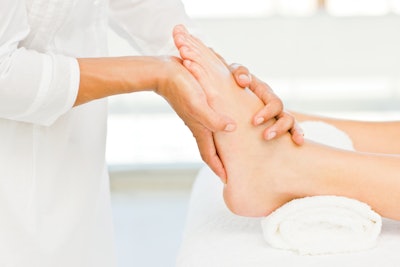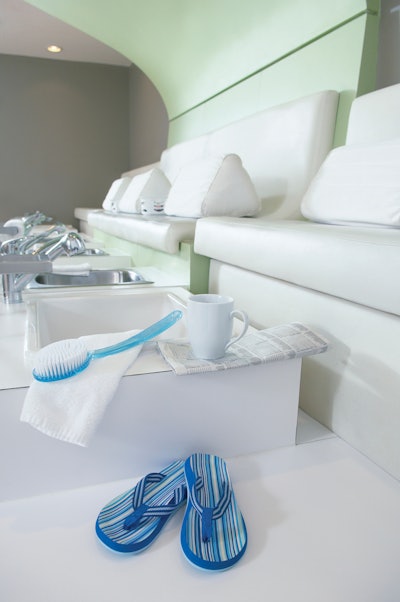From arthritis to backaches, pain is extraordinarily common. Find out how to modify your services for clients who suffer from painful conditions.
For most, a trip to the nail salon is a luxury and an escape from the stress of daily life. However, if a client is suffering from a painful condition, checking her problems at the door and indulging in a little R&R is no easy task—and the odds of an issue are higher than you might think. According to the National Center for Health Statistics, approximately 1 in 4, or 76.2 million, Americans suffer from pain that lasts for more than 24 hours, and millions more are plagued by acute pain. But while afflictions like arthritis, back or hip pain, and even bunions can present challenges, there are plenty of things you can do to ensure your client still walks away completely satisfied—and perhaps even feeling better—after her service.

Talk to Me
In most cases, the routine pre-treatment consultation is a way for you to get acquainted with the client and discuss her preferences for the service(s) she’s about to receive. But this is also an opportunity to pinpoint health problems and painful conditions. Specifically, ask about any pain-related issues your client might be experiencing, suggests Jaime Schrabeck, owner of Precision Nails in Carmel, California. “We ask very general questions about client health, starting with, ‘What would you like to tell me about your hands and feet before we start your service?’” Schrabeck says. “This gives clients a chance to caution us about any chronic conditions or other health concerns, including pain.” Janet McCormick, co-owner of NailCare Academy in Fort Myers, Florida, says it’s even a good idea to take it a step further and provide a questionnaire with a checklist that includes any past or current health concerns. “Every new client sheet must ask about conditions the client has, such as arthritis,” she says. “Always ask questions like, ‘Do you have chronic pain and, if so, why or what kind?’” Because health-related issues can be sensitive topics and something clients might not be inclined to share right off the bat, make sure it’s understood that this consultation is for their benefit only and completely confidential, adds Schrabeck.

Make Adjustments
As skillful and soothing as your services may be, there will always come a time (and a client) requiring you to switch things up, and that’s especially true when you’re accommodating painful conditions of any kind. Conditions like arthritis, back or hip pain, and bunions can often be exacerbated by the slightest touch or pressure, so even routine techniques like massaging of the feet and hands can cause painful flare-ups. To be sensitive to every type of condition, it’s vital to have a Plan B in place.
For arthritic conditions, McCormick first suggests modifying your massage approach. “A gentle massage on an arthritic client should never go over a joint, and even gentle toe-pulling should not be performed,” she says, recalling a former technician who did pull the toes of an arthritic client, which unfortunately created more severe and lasting pain. As for other foot-related conditions, such as bunions, which affect 25 percent of adults between the ages of 18 and 65, McCormick says she avoids massaging the affected area altogether.
When working on a client with hip pain, it’s more about modifying the way you position and move the client. “Nail techs must be aware of range of motion,” says Rubina Tahir, D.C., a chiropractor in Philadelphia. “If a client has hip pain, movements of that extremity should be minimal and gentle, and you should avoid sudden jerky motions.” It’s also a good idea to have extra pillows and even reclining seats, if possible, to ensure the most comfortable positioning possible. “For hip pain, I recommend placing a small pillow under the hamstrings (backs of the thighs), not under the buttocks, while the client is in the chair,” says Tahir. “This puts slack in the hamstring muscles, relaxing the sciatic nerve and keeping the hip joint in a comfortable position.”
To encourage a safe seated posture for those with low back pain in particular, Tahir advises against offering magazines or even allowing clients to look at their smartphones during a service. “Reading a magazine will promote the neck in forward flexion, pulling on the muscles and forcing the low back to compensate,” she explains. “This can further irritate the low back during the service.” Instead of offering reading material, you might engage in conversation or provide headphones so they can listen to music. This will have the added effect of putting your client in a relaxed state. “Your job as a nail tech is to keep them focused on deep breathing and relaxing in the chair,” says Tahir.

Keep in Touch
Because chronic pain can be sporadic and unpredictable, it’s always a good idea to go above and beyond the call of duty to keep your client as comfortable as possible. So, in addition to the aforementioned modifications and accommodations, keep the lines of communication open and check on how they’re doing throughout the service. “Clients dealing with pain should be asked ‘Are you comfortable?’ several times,” McCormick says.
In fact, studies have found that a positive attitude can help with pain management. The simple act of expressing extra concern for a client’s painful conditions and overall wellbeing will not only improve their outlook, but make your services all the more welcome and therapeutic at a time when they need it most.
-Angela Melero
What’s your best advice to tailoring services to help ease your clients’ painful conditions? Let us know in the comments below!
[Images: Courtesy of GettyImages/ENERGY/istock, GettyImages/Neustockimages/E+, Monalyn Gracia/Corbis/VCG]
This article was first published in the April 2017 issue of NAILPRO
Read More:











